Disclosure: Meeple Mountain received a free copy of this product in exchange for an honest, unbiased review. This review is not intended to be an endorsement.
As a fan of tabletop roleplaying games, there’s nothing I like better than introducing new players to the genre. It’s an alchemical process: sitting down together, agreeing to play in a world almost entirely of our creation, and then transmuting those unexpected details and dangling story threads into a powerful cathartic experience. But over and over I hear the same thing from new players: “I don’t know how I could make a character. I’m just really not creative.”
“Poppycock,” I say theatrically. “You already have a thousand characters in your mind. All you need to do is find one.”
As a writer and a former actor, I firmly believe that we’re surrounded by characters. From the stars of the latest Hollywood blockbuster to our own loved ones, inspiration is everywhere. Yet some players remain extremely hesitant, firmly convinced that they could never enjoy an RPG without delivering an award-winning performance backed by meticulous character development. For those players, something else is needed, some way to prove to them that they have the capacity for creation. I’m always on the hunt for new ways to get them out of their own heads and into the game.
Which is why Roll For Your Life, from 3 Much Games, caught my eye. This book promises to help both new and experienced players create a playable character for any roleplaying game in 15-20 minutes of light gameplay. That’s potentially a very useful tool, but does it actually work?
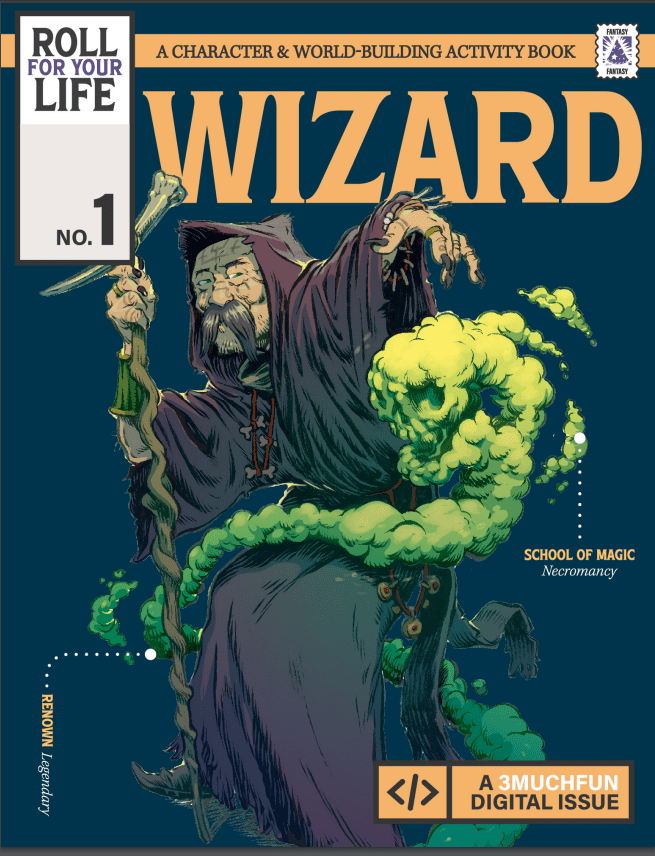
Table Talk
Roll For Your Life is a storytelling exercise that uses randomized prompts to create a character. The book consists of roughly 15 chapters that all use the same mechanics. (For this review, I played through two chapters, though all chapters should work essentially the same way.)
To play, simply pick a chapter–Wizard, perhaps, or Noir Detective, or the villainous Mastermind–and start rolling dice. Each chapter consists of a set of 10-15 tables, each with at least 6 numbered keywords. Start at the first table, roll your die, and write down the keyword associated with that roll. While each keyword contains additional suggestions, the keyword itself is the main point here. Some chapters and tables include more complicated rules, such as rolling multiple dice. Each chapter also features a set number of “do-overs”: players can reroll up to that number of times over the course of the chapter.
In practice, this means that you’ll be rolling up a random character and then stringing the pieces together to figure out how it all works. This is, frankly, a great way to introduce a new player to roleplaying’s most difficult challenge: adjusting to new creative input on the fly.
We’ll Do It Live!
Let’s walk through the process step-by-step. Imagine we’re playing a juicy sci-fi RPG about exploring wrecked spaceships while being chased by a horrible alien monster–surprise, I know a game just like this–and we want to create an idea for the aliens. We open up our copy of Roll For Your Life to the chapter “Alien Species”. At the top of the first page, this specifically calls out that there are 14 tables associated with this chapter and that we have 2 do-overs available to us.
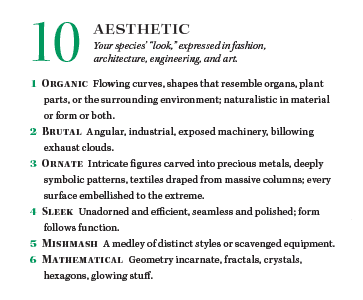
Starting with the first chart, Biology, we roll a 6. The result we get is Energy Processing: our aliens have an unusual way of gaining energy, such as photosynthesis. I could write down “Energy Processing: Photosynthesis” and move on, but I want something a little weirder. I’m going to write “Energy Processing: Eats Heat” instead. What does that mean? I don’t know yet! It sounds interesting though.
On the next chart, Physical Form, we get a 2: Unusual Appendages. I’m not sure what this could be yet. A long tail? 12 short legs? 2 heads, or maybe no head at all? Nothing immediately jumps out at me, so I write “Unusual Appendages” down and leave it for later.
On the third chart, Special Ability, we roll a 1 which means Physique. Our aliens are super-strong, super-fast, or otherwise much more powerful than a human. That’s pretty interesting, and certainly fits for the setting. However, I’m going to spend 1 of my 2 do-overs to reroll and see if something else sparks my imagination. I roll a 2, replacing Physique with Psychic: these aliens have telekinetic abilities or can mess with our minds in some way. I might have preferred Physique, but since I used the do-over I’m stuck with Psychic. Given the horror aspect, I’ll give these creatures the power to disorient the unwary and cause them to lose their way. For this particular game, that may not have any mechanical weight; if we were playing a different RPG, we might represent this through special abilities.
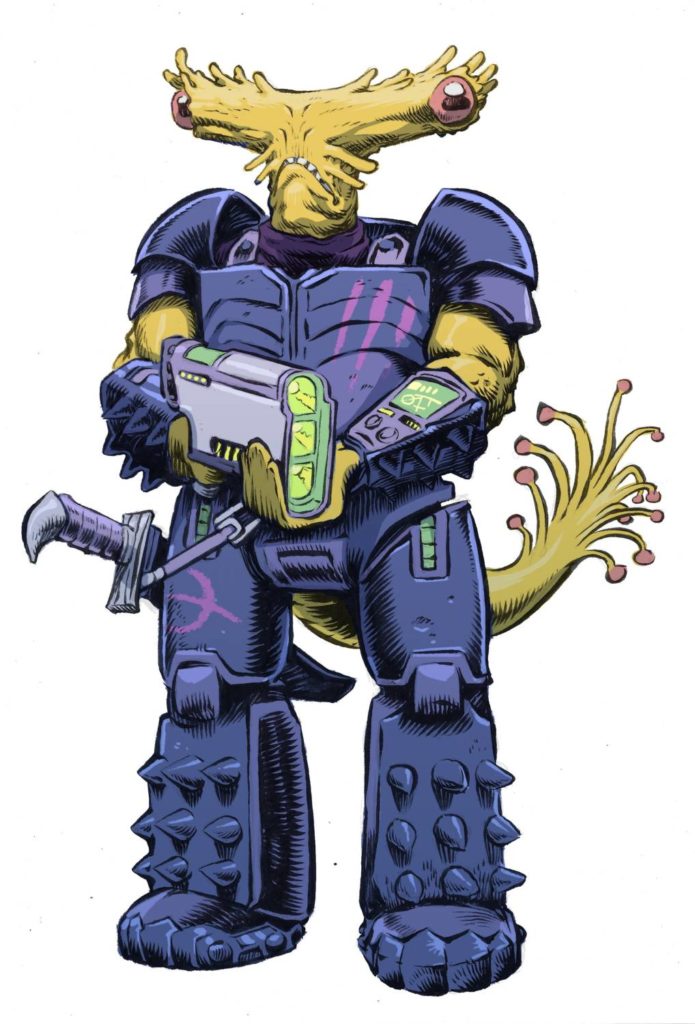
I’ll spare you the remaining rolls, but here’s what I came up with in the end.
The Yurg are a dangerous race of predators. Their disorienting psychic abilities confuse and frighten their prey; once their target’s heart rate is elevated, they close in and grab them with their long multijointed arms, using the surface of their exposed skin to feed on siphoned heat until the victim dies of hypothermia. Most of their bodies are chitinous, other than the arms, affording them significant protection against direct attack. Though they once kept largely to their own planet, it was destroyed when a nearby star went supernova; the Yurg’s obsession with spreading across the galaxy and repurposing destroyed ships is undoubtedly related to their fear of being trapped in a similar catastrophe. Connected by a single hive mind, they possess incredible engineering skills and typically communicate in mathematical language rather than specific words. They often pick up scrap across their travels, using it to repair vessels as well as create extensive traps with which to ensnare the unwary.
Not bad for 15 minutes of work!
Carte Blanche
Roll For Your Life is pretty straightforward to use, and though most of the tables play to existing tropes, there are some fun surprises. While designing the Yurg, I got an unusual Cultural Feature that suggested the Yurg valued something that other races find useless. That entry caught me off-guard and led me to add some details that I might otherwise have overlooked–specifically, that they might pick up scrap not only to repair damaged ships but to create traps, which dovetailed with their disorientation effects to create an interesting threat. Unexpected twists like those are a boon for this kind of creative project.
Of course, this isn’t particularly new: characters have been built using random rolls (or some other method to mix up creative sources) for much longer than I’ve been in the hobby. While the tables have been nicely curated, experienced players may find that they already have a few tools which serve this purpose. Reading over the example I wrote above, I wonder how much of it I might have been able to create on my own without any prompts at all, or by simply selecting a single prompt or two to add depth to an existing idea. The ease and speed with which I was able to put together something useful is definitely a point in the book’s favor, though. A harried Game Master could quickly assemble a major non-player character in the span of a short snack break, adding stats or other details afterwards.

What I find most interesting about Roll For Your Life is that it’s system-agnostic. That is to say, if you make a Wizard using this book, that Wizard can slot into your one-shot Dungeons & Dragons session as easily as your long-running Shadowrun campaign. In the example above, I could have used the exact same set of keywords to create a race of friendly telepaths who feed only on inanimate sources of heat, causing them to gravitate towards abandoned spaceships where they can drain the last vestiges of power in peace. Or, if I were planning to play as a member of this species, I could say that they’ve adapted to space travel by carrying portable reactors, “drinking” from them the same way we might drink from a water bottle. I could even move this alien species to a fantasy world, causing them to eat fire-based spells or live inside of active volcanoes. The keywords are seeds from which to grow a bigger idea, and it’s entirely up to the player to harvest something useful from this crop.
Another aspect I appreciate is 3 Much Games’ decision to offer both the full compendium of 15+ chapters as well as selling individual chapters a la carte from their website. For some players, they’ll want everything on hand, easy to grab in a pinch. Others can buy a single relevant chapter or two for their next session.
I should say, though, that having the full book does offer the luxury of letting one look through the artwork at their leisure. Conor Nolan has packed this book with absolutely gorgeous, whimsical, occasionally weird illustrations that offer plenty of inspiration on their own. Many of them explicitly pull elements from the tables, showing at a glance how a concept might come together. The art really highlights how flexible these charts can be and goes a long way to selling Roll For Your Life as a physical product.
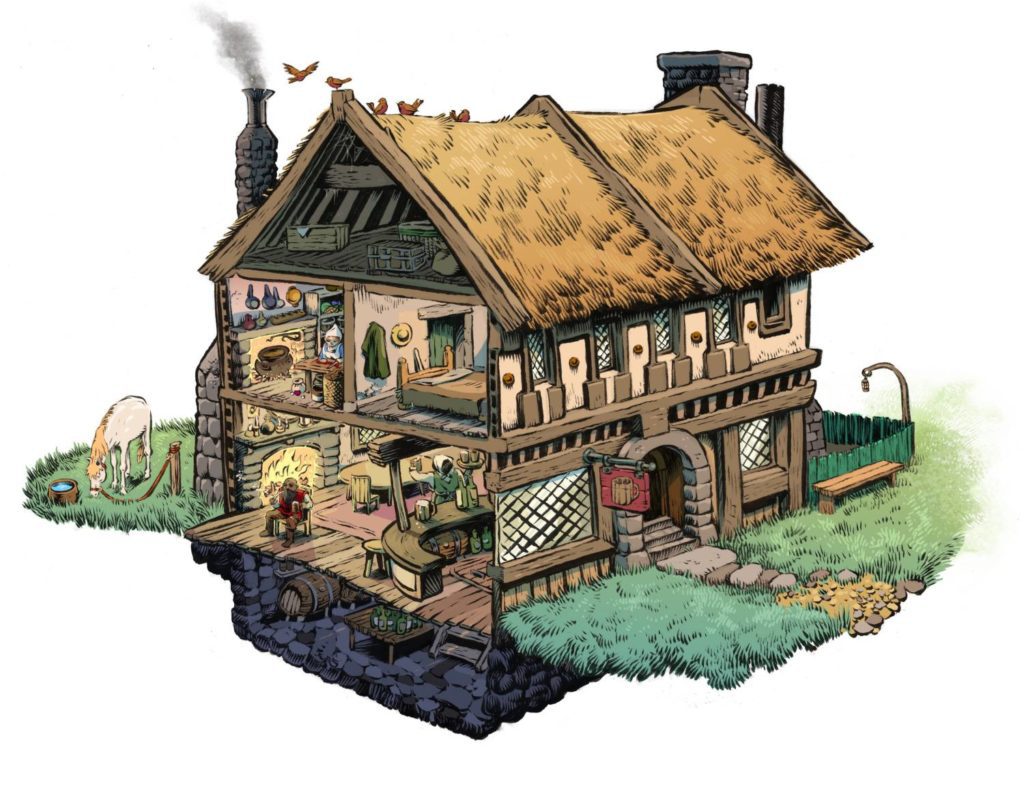
I don’t necessarily think Roll For Your Life is something that every roleplaying fan should have on hand. It’s perfect for those just getting started (or someone who plays largely with new roleplayers) and would make a fantastic gift for a young RPG enthusiast. If I had received this in elementary school, when I was first discovering RPGs, it instantly would have taken pride of place on my bookshelf. Experienced players probably don’t need what this book offers, but may still wish to pick up a few chapters from the website as needed to break through a creative block. Game Masters and writers may benefit more from the full book, enabling them to generate interesting hooks on the fly that they can further refine over time.
For those who can make use of it, Roll For Your Life offers a compact, quick source of potentially endless inspiration. If that sounds like something you need, check out the Kickstarter now!



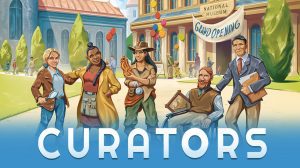
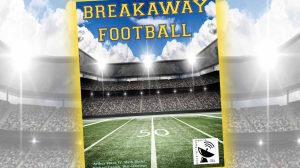
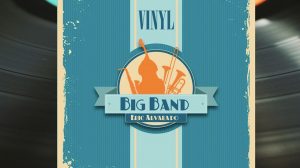
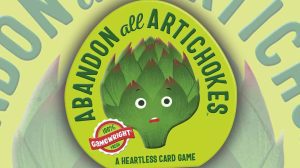




$40 MSRP for a PDF, yeah hard pass.